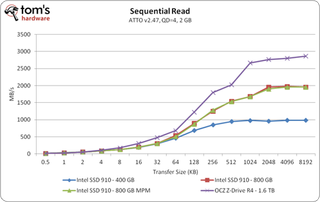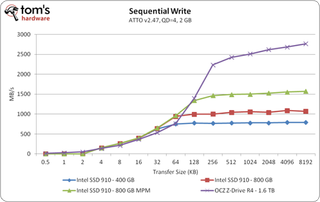Intel SSD 910 Review: PCI Express-Based Enterprise Storage
PCIe-based SSDs have evolved rapidly, with companies like Fusion-io, LSI, and OCZ leading the way. Intel is betting that its reputation for quality and reliability in the enterprise sector are enough to overcome that head-start as it launches SSD 910.
Sequential Performance

The 800 GB SSD 910 hits it 2 GB/s sequential read speed specification at a block size of 2 MB, while the 400 GB version achieves its 1 GB/s spec at a block size of 512 KB. The R4 is still the clear winner at larger transfer sizes, though.

Maximum Performance mode finally sets itself apart from Default mode in our sequential write speed test. Commit this one to memory, though, because this is only time you'll see a difference. But what a difference it makes, granting a 50% boost in sequential writes.
That's not enough to match the R4, which peaks at 2.8 GB/s. However, the news isn't all bad for Intel, since these tests do employ highly-compressible data, which favors the R4's SandForce-based controllers.
When we switch to AS SSD and use fully random data, the gap between Intel and OCZ evaporates.

The R4 still edges out Intel's drive, but the results are much closer. The SSD 910 pulls within 100 MB/s in the sequential write test.
Stay on the Cutting Edge
Join the experts who read Tom's Hardware for the inside track on enthusiast PC tech news — and have for over 25 years. We'll send breaking news and in-depth reviews of CPUs, GPUs, AI, maker hardware and more straight to your inbox.
Current page: Sequential Performance
Prev Page Enterprise Workload Performance Next Page Enterprise Video Streaming Performance-
that is one fast Sequential read speed. It to bad that they will be $1000+ market and out of reach of all but the server/ workstation crowdReply
-
The OCZ is tested with compressible data? talk about best case scenario. what were the incompressible results like?Reply
-
s3anister PCI-E Solid State Storage is great but I can't help but wonder; where is the Memristor? The true performance gains to be had are with massive RAM-disks that aren't volatile.Reply -
apache_lives The most important and un-comparable factor here is 5 years later those Intel SSD's will still be functional, any other brand im surprised they last 5 months in normal machines with the failure rates i have seen first hand - OCZ, GSkill etc there all horrible i bought an Intel SSD for this reason - THEY WORK.Reply
Review sites never cover real world use - that is to live with it day in day out (reliability), its not all about raw speed and performance. -
ZakTheEvil Yeah, consumer SSD reliability is a bit of disappointment. At best they seem to be as reliable as hard drives.Reply -
georgeisdead This is a note to address several articles I have come across lately that state intel's reputation for quality and reliability in the SSD market as if it is a given. These comments are from my personal experience with intel's drives. I have owned 3 intel solid state drives, one X25-M G1, and two X25-M G2's. The X25-M G1 failed after 2 years while one of the G2 drives failed after 2.5 years. Now, I am not an expert on MTBF and reliability, but in my opinion this is a pretty poor track record. It is entirely possible that this is a coinicidence, however both drives failed in the same manner, from the same problem (determined by a third party data recovery specialist): Bad NAND flash.Reply
As best I understand it as it was descibed by the company that analyzed these failed drives, a block of NAND flash either went bad or became inaccessible by the controller rendering the drives useless and unable to be accessed by normal means of hooking it up to a SATA or USB port. Two drives, different NAND (50 nm for the G1 and 34 nm for the G2), same failure mode.
Once again, this is not definitive, just my observations but to me, I think review sites need to be a little more cautious about how they qualify intel's reputation for quality and reliability because from my perspective, intel has neither and I have since began using crucial SSD's. Hopefully, I will see much longer life from these new drives. -
jdamon113 I would like to see something like this stacked in our EMC, Could this drive with a rack of othere just like it, run 24/7 for 3 + years, Sure we replace a drive here and there in our EMC, but the unit as a whole has never went down in its 5 year life.Reply
Intel, you should test these drive in that real world application. EMC, VM-ware and several data bases carve out some LUN's and Push the envelope. In this situation, should the device prove worthy, the 4000 price tag will come down very fast, and the data center will put it trust in product, So for those reading this for your personal home workstation and gaming ridge, you need not apply in this arena.
Intel is just about 18-months 2 years of owning the data center, Even EMC is powered by intel. -
jaquith Enterprise e.g. SQL you need SLC otherwise you'd be making a career replacing drives. The cost is down time and replacement. I can write more 'stuff' but it's that simple. For our IDX and similar read data it about reliability and capacity.Reply -
willard razor7104that is one fast Sequential read speed. It to bad that they will be $1000+ market and out of reach of all but the server/ workstation crowdThat's because this was not designed for consumers. It's not like they're marking the price up 1000% for shits and giggles. Enterprise hardware costs more to make because it must be much faster and much more reliable.Reply
This drive, and every other piece of enterprise hardware out there, was never meant to be used by consumers. -
drewriley jimbob rubaeThe OCZ is tested with compressible data? talk about best case scenario. what were the incompressible results like?Reply
Check out the Sequential Performance page, lists both compressible and incompressible. For all the other tests, random (incompressible) data was used.
Most Popular

